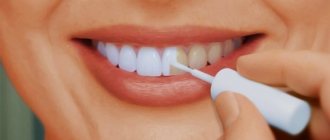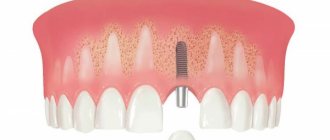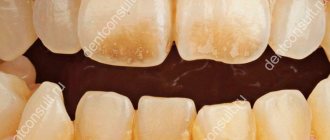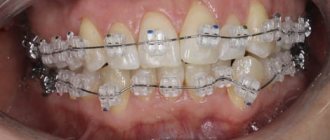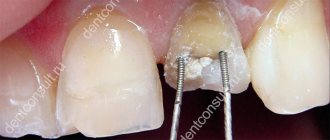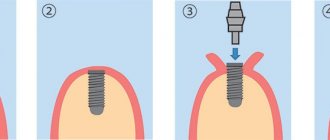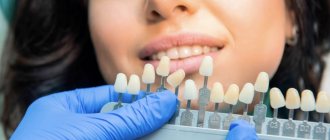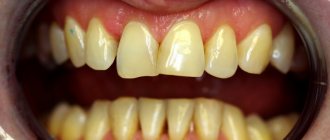Veneers are thin overlays, mainly made of ceramics, that are installed on the front surface of the tooth and the cutting edge. They are used to correct irregular shapes, hide chips and cracks, and eliminate excess gaps. But the most common reason why patients decide to have these miniature dentures installed is the desire to give their teeth a lighter and more even shade. Chemical whitening does not always give the desired effect and requires regular repetition, but veneers solve aesthetic problems comprehensively and for a long time.
How is the color of veneers determined?
To select the color of ceramic microprostheses, dentists use a special scale called Vita. It includes:
- 16 natural shades;
- 4 ultra-whites that practically do not exist in nature - Bleach.
Thus, you can choose the appropriate color from as many as 20 options. If the patient only needs a few restorations, the shade of the veneers should match the color of the adjacent teeth. However, if microprostheses are placed over the entire smile area, then the patient is free to choose any color he likes, based on his ideas about beauty and the doctor’s recommendations.
Naturally colored veneers according to the Vita scale are presented in the form of four blocks in accordance with the enamel undertone:
- A - red-brown;
- B - yellow-red;
- C - gray;
- D - gray-red.
There is no need to be alarmed: such a classification does not mean that the selected sample will be red or gray. Only a specialist will see the difference between the tone of ceramic veneers; for patients, they look approximately the same - like ordinary natural teeth.
Each of the four blocks contains four shades, grouped by brightness: from the lightest to the darkest. They are designated by the numbers 1, 2, 3 and 4. Accordingly, all tooth colors on the Vita scale have their own alphabetic and digital number - for example, a2 or b1.
What is zirconium dioxide?
When creating dental prostheses, metals are used, since one of the indicators of the quality of crowns is their reliability and resistance to stress, but not in their pure form. So many dentists recommend zirconium crowns. However, to create prostheses, it is not pure metal that is used, but zirconium dioxide, which is a material of increased strength.
Increasingly, in implantology, despite the high price, zirconium crowns are used. What is their advantage over other materials for prostheses? First of all, it is durability and color. In orthopedics, zirconium dioxide is called “white gold”. Its color is as close as possible to the natural shade of the teeth, which allows you to achieve greater naturalness after prosthetics. If the installation process is carried out in accordance with all requirements, the structure can last up to 20 years.
Since dentures made of zirconium have an impeccable appearance, they are often used in the reconstruction of anterior teeth. The material has a certain degree of transparency, thanks to which it easily adapts to the natural shade of the enamel, thus, does not stand out among the entire dentition.
The most popular colors of ceramic veneers
The standard for a beautiful smile is straight, light teeth that look natural. Aesthetic dentistry helps to achieve exactly this effect, so it is not surprising that the most popular shades on the Vita scale are considered to be the first numbers in tones A and B.
✔
Patients who want natural veneers are most often attracted to color a1 (photo). This is a light pearl shade, close in brightness to the Bleach range, but without artificial whiteness. This color is refreshing and, without exaggeration, rejuvenating, because, as we know, in our youth our teeth look much whiter.
✔
The color of A2 teeth is a little darker, but only a doctor can distinguish such veneers from natural teeth - those around you will be sure that your smile is so naturally beautiful.
✔
Another favorite tooth color for many is b1. It's just as light and bright as a1, but has a different tonality that will be preferable for certain skin tones.
White or natural color?
Everyone knows that veneering is the most painless and effective way to eliminate visible dental damage. With age, teeth are subject to wear and tear, and this affects their appearance. As a result, the functioning of the muscles of the oral cavity is disrupted, and the quality of chewing functions decreases.
The canines and incisors are shortened, which leads to bite deformation. In order to minimize age-related manifestations and the formation of facial wrinkles in the area of the nasolabial triangle, aesthetic dentistry offers veneering. We are talking about adding the missing height and volume to the teeth.
Aesthetics and whiteness do not go unnoticed. Some patients resort to veneering in the hope of whitening their teeth by several shades. But experts recommend observing the measure, since excessive whiteness of some elements will visually emphasize the yellowness of others.
Bleach teeth color - Hollywood smile
No matter how much natural beauty is valued, many patients dream of a dazzling white smile, like that of movie stars. For such cases, the Vita palette includes four snow-white shades “Bleach”, which do not exist in nature.
Bleach 1 and Bleach 2 are bright white enamel with virtually no yellow pigment. Such shades are associated with shockingness and can only look good on stage, in the spotlight and against the backdrop of bright makeup. In shades Bleach 3 and Bleach 4 a small percentage of yellow pigment appears, but they still remain outside the natural palette.
The bleach color of ceramic veneers looks more appropriate on dark skin. Those with Northern European appearance are better off giving preference to natural shades a1 and b1 - they are just as light, but look more organic.
Metal-ceramic dental prosthetics
The technology has proven itself most actively in the restoration of chewing teeth, where not only aesthetics, but also strength are important. The widest range of ceramic coatings for dentures allows the material to imitate the structure of human dental tissue as accurately as possible.
Inexpensive metal-ceramics are used a little less frequently for the correction of front teeth, because the metal frame can be seen through the thin ceramic coating. That is why, for prosthetic treatment of front teeth, A-Medic dentists recommend that patients opt for ceramics based on zirconium. Essentially, this is the same metal-ceramics, which is based on white metal. Zirconium metal ceramics can be installed on any patient, even those prone to allergies, because the material is 100% biocompatible with the human body.
Colors of Emax ceramic veneers
Emax glass-ceramic microprostheses differ from conventional ceramic veneers in their manufacturing technology. Accordingly, for overlays of this type there is a separate color scale - Vita 3D-Master. Here, not two, but three color selection options are used.
- Brightness - from 1 to 5.
- The tonality is L (more yellow) and R (more red).
- Saturation - from M1 to M3.
To determine the shade of the future veneer, the doctor first determines its brightness, moving from the darkest to the lightest, then selects the intensity level M and, lastly, the tonality L or R. The color codes of the Vita 3D-Master palette consist of three symbols - for example, 3M2 .
Dental metal ceramics. What does the crown look like?
Metal-ceramic dental prostheses have a simple design. This is a metal frame, coated with hypoallergenic ceramic. Compared to previous composite prostheses, this design has a number of significant advantages:
- the material reproduces well the color and texture of natural teeth;
- ceramics do not absorb food dyes and do not fade over the years;
- the product is hypoallergenic, therefore it does not cause side effects in the first days after installation;
- The prosthesis turns out to be very strong, capable of withstanding heavy loads that are applied to the chewing teeth every day.
Dentistry "A-Medic" offers patients removable and non-removable ceramic dentures. The installation of a removable orthodontic structure is justified if the patient has a number of contraindications to the installation of permanent metal or ceramic dentures. The dentist will help identify the presence of such contraindications after a visual examination of the patient’s oral cavity and study of the general history.
What color of veneers should I choose?
A doctor will help you find the right shade for your restorations, ideally together with a dental technician.
If it is necessary to restore the aesthetics of individual teeth, the color of the onlays is selected in accordance with the shade of the “neighbors”. Before getting veneers, you may be recommended a whitening procedure to make your teeth 1-2 shades whiter and choose lighter veneers. Using a palette, the doctor determines the color of each restoration separately, since the central incisors, lateral incisors and canines naturally have different colors and degrees of brightness.
If we are talking about installing veneers on all teeth, then certain rules apply for choosing a shade.
Dentist color selection
To select a shade that is as close as possible to natural, a specialist determines the color of the tooth at three points: the incisal-occlusal part of the tooth, the middle and cervical. After all, our teeth have a different shade of surface at the gum and tip. This is influenced by the health of the tooth and gums itself, as well as the thickness of the enamel.
In the process of selecting the color of veneers, the doctor is guided by the following rules:
- The color of the enamel must be determined only in natural (daylight) lighting, and its intensity should be no more than 1500 lux. Failure to comply with this condition may result in an error when determining the brightness of the hue. Today, many clinics have special installations that simulate daylight. They allow you to adjust the light intensity and provide ideal conditions for selecting the desired shade of dentures.
- The interior of the dental office should be designed in light colors, since any bright objects distort color perception and it is much more difficult for the doctor to correctly determine the color of teeth and veneers. This also applies to the dentist’s clothing, accessories and gloves; the flashy color of any detail can negatively affect the final result.
- teeth must be moisturized, since dry enamel reflects light completely differently.
- the environment should be calm and friendly.
Metal ceramics are inexpensive. How are dentures installed?
Installation of ceramic dentures occurs in several stages. First, the patient needs to make an appointment with the selected dentist, undergo diagnostics and dental treatment, if necessary. Also, a mandatory stage of prosthetics is a general diagnosis of the body and a study of the patient’s medical history at the time of identifying contraindications. The dentist then follows the following therapeutic plan:
- preparation of teeth for a crown (grinding down enamel, removing nerves);
- taking impressions from the received supports, according to which an individual orthodontic design will be made in the future;
- fitting of prostheses, their polishing and correction:
- installation of the structure.
On average, dental prosthetics with metal-ceramics at the A-Medic clinic takes about two weeks. Dentists draw the attention of patients to the fact that when choosing a ceramic design, a more gentle grinding of tooth enamel from the supporting tooth is performed. This is possible due to the small thickness of the ceramic coating. Metal-ceramic dental prosthetics does not require complete grinding of bone tissue, so the risk of irritation, swelling and allergies after inserting the prosthesis into the oral cavity is minimal.
